Once you have
configured a freezer with some terminal storage units, you can assign samples to the Freezer Management location corresponding to their physical location in the real freezer. Any protocol about where to place samples of different types can be accommodated in this system.
To add samples to storage, the user must have been granted the
Storage Editor role. This applies to administrators as well as other users. This topic assumes the user has this role.
Start from the Freezer
Start from a Picklist or Grid of Samples
Start from the Freezer
Find Available Space
Start from the
Freezer List on the application home page, or the freezer dashboard. You'll see a summary of storage and how many spaces are available for samples in each freezer to guide you.
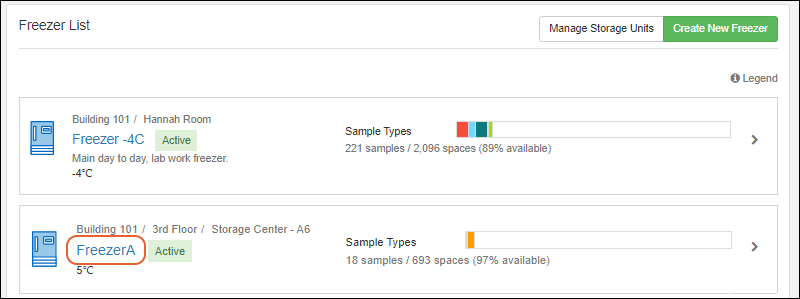
Click the name of the freezer to open the details page.
- Here you'll see the top level of the storage hierarchy you defined (in this example three shelves).
- Click the to expand the nested hierarchy.
- Click any level to see the available capacity in the panel on the right.
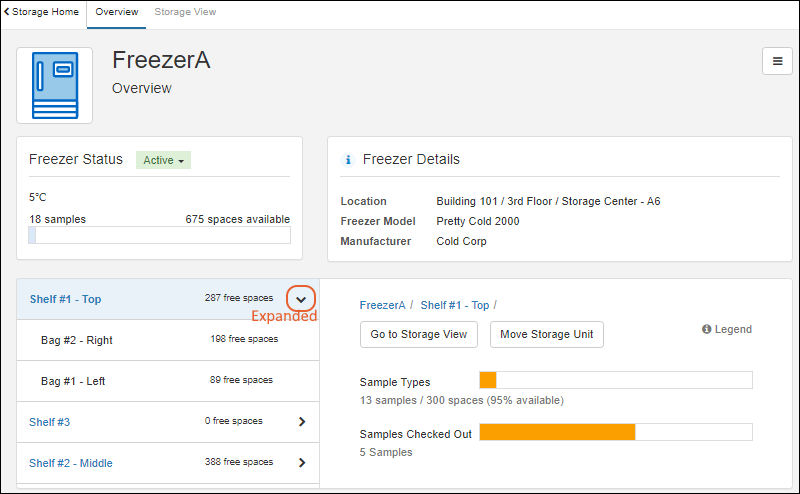
Continue to use the
to expand until you find enough capacity in terminal storage units where samples can be stored, such as bags as shown above.
Click any location in the left panel to show it's summary information on the right. You can only store samples in "terminal" storage locations: bags, boxes, canes, plates, and tube racks. In this case we choose a bag on the top shelf.
- Click Go to Storage View to open it, shown here "Go to Bag #1 - Left".
- You can also click the location name in the 'breadcrumb' trail along the top of the panel.

You are now on the
Storage View tab for this freezer, open to the location you selected.
Select Space to Fill
There are two categories of terminal storage units to which you can add samples.
- 1. Bags and Canes use a simple numbering scheme for positions.
- For bags and canes, you don't need to do anything except click Add Samples to activate the sample panel on the right.
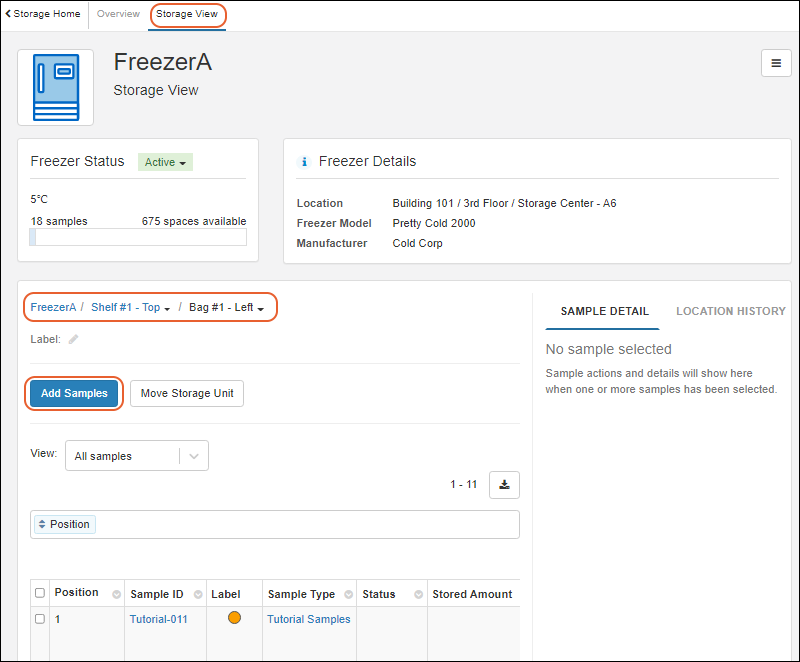
- 2. Boxes, Plates, and Tube Racks have a 2D layout of row and column positions (aka cells, spaces, wells, etc.) within the unit. You have two choices here:
- Click cells or drag within the layout to select a range of positions, as shown below, then click Add Samples. The selected positions will be eligible for placing samples.
- OR, click Add Samples without making any selection. All available positions will be eligible for placing samples.
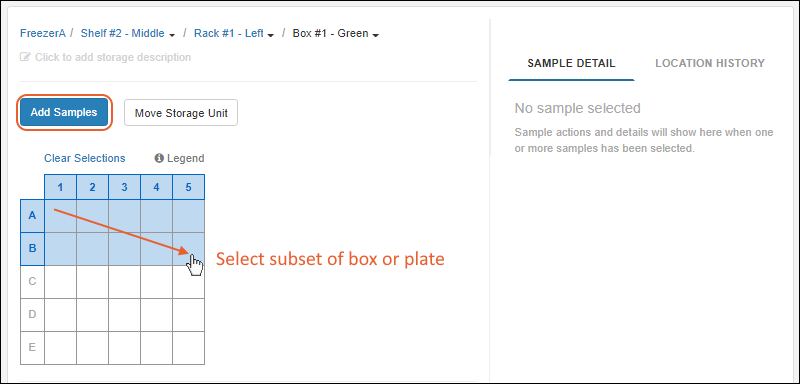
Position Already Occupied
If you select a range of cells and one (or more) are already occupied by samples, you will still see the relevant rows in the
Add Samples grid, but the occupied rows are shaded red and cannot be edited or used to place new samples.
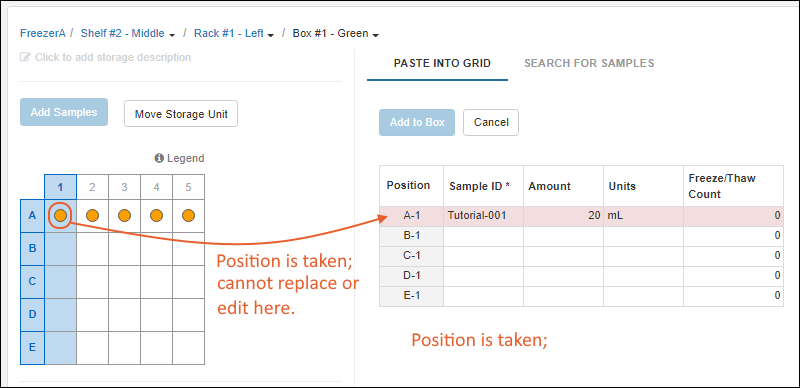
Identify Samples to Store
Once you have clicked
Add Samples, the right side of the panel becomes your sample identification region.
Paste into Grid
You can
Paste into Grid from a spreadsheet or by typing directly into the grid shown:
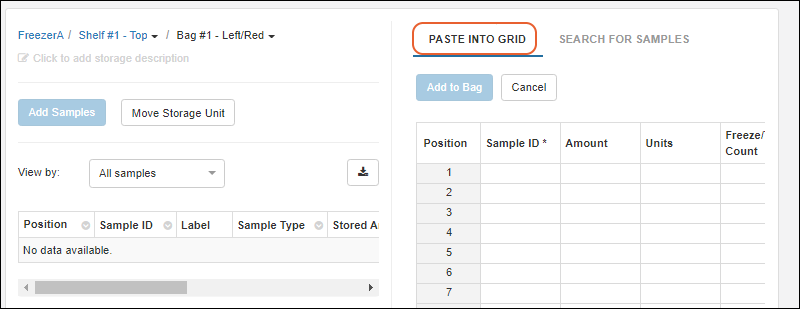
Values added to the
Sample ID column must already exist in the system. If you start typing you will see a narrowing list of available samples. Note that this means if you received a new set of samples, you must first add their data to a Sample Type (or create a new one) and can then assign them to locations in a freezer.
Search for Samples
Click the
Search for Samples tab to get more assistance with finding specific samples.
First, select the desired Sample Type from the dropdown.
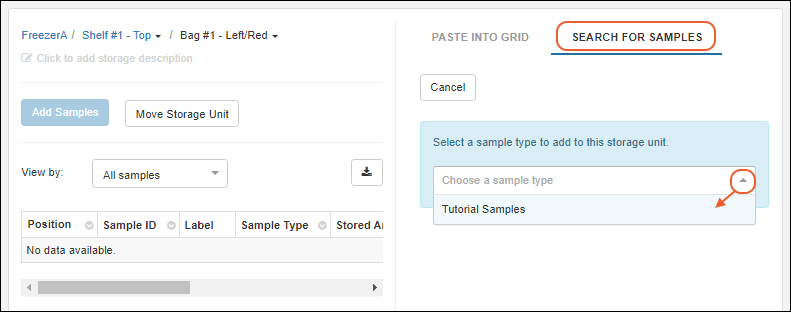
Once a Sample Type has been selected, you can:
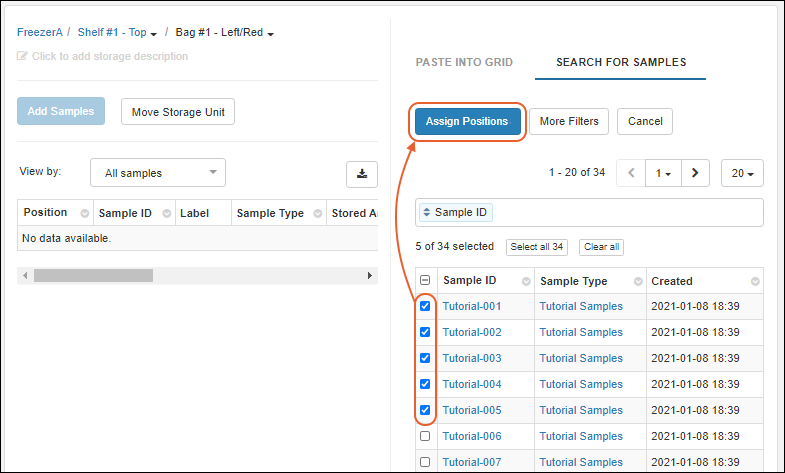
See below for how to
Assign Positions once you've identified the samples you want to store.
More Filters
Click
More Filters on the
Search for Samples tab to select on or more of the filter options:
- From Source: Select a specific source to see samples derived from it.
- From Parent: Select a sample to show all its child samples.
- Created By: Find samples added by a specific user.
- From/To: Find samples created in a specified date range.
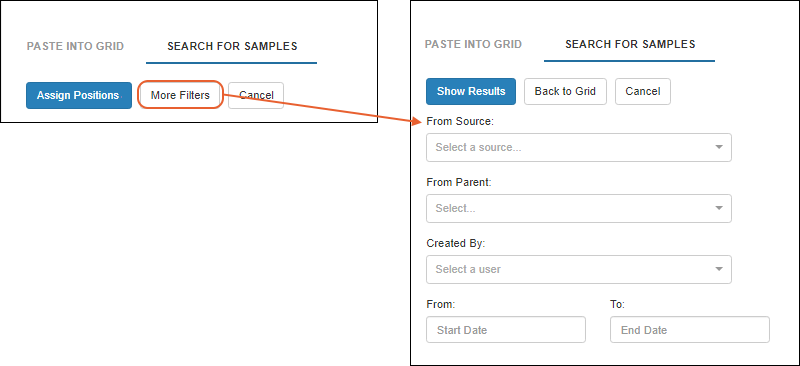
- Click Show Results to see the samples that match your filters.
- Use checkboxes to select the samples of interest, then click Assign Positions, or return for More Filters.
- Once some filters are applied, you'll be able to click Clear all filters to clear them.
- Use Back to Grid to return to the previous set of selected samples.
Assign Positions
Once you've filtered to find the samples you want, use checkboxes to select the ones you will be adding to this storage unit.
- Note: If you select more samples than there are spaces available, you will see an error message telling you to reduce the number of selected samples before proceeding.
Click
Assign Positions.
The selected samples are shown in a numbered position-assignment table on the right. You can directly edit the grid to provide:
- Position:
- In the case of a bag, the numbered position is not meaningful.
- For a cane, it could be numbered from top to bottom (or bottom to top) as your convention dictates.
- For boxes, plates, and tube racks, the Position column shows row/column position numbers corresponding to the layout on the left. By default the samples will be placed in the first available layout positions (using left to right, top to bottom sequencing). You can adjust these default assignments by moving the row in the grid to the row for another available position in the layout.
- Sample ID: the selected samples are listed, but you can add more rows directly. Sample IDs must already exist in the system.
- Amount: Volume
- Units: Units for that volume (mL, mg, etc.)
- Freeze/Thaw Count: The default is zero. If you know the sample has been thawed and frozen before, you can edit this value.
Bag or cane:
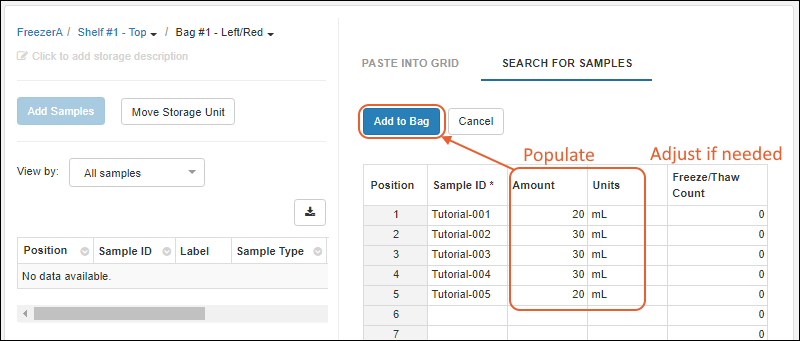 Box, plate, or tube rack:
Box, plate, or tube rack:
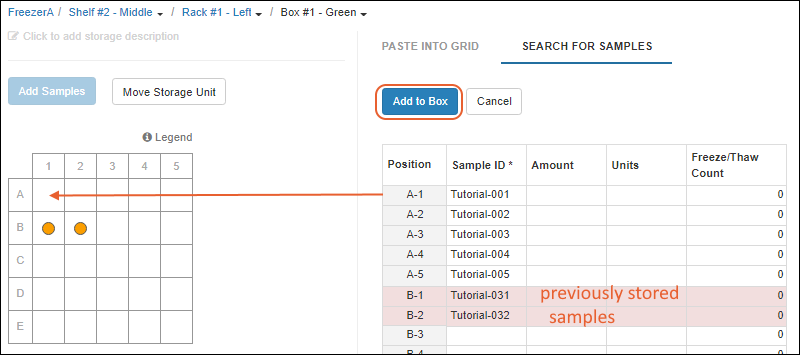
Add to Storage
Click
Add to [Storage Type] to complete the position assignments.
After assignment is complete, you will see the
Storage View for the location.
- The newly-added samples will be selected in the grid.
- In the case of a box, plate, or tube rack, the cells containing the newly placed samples will also be highlighted.
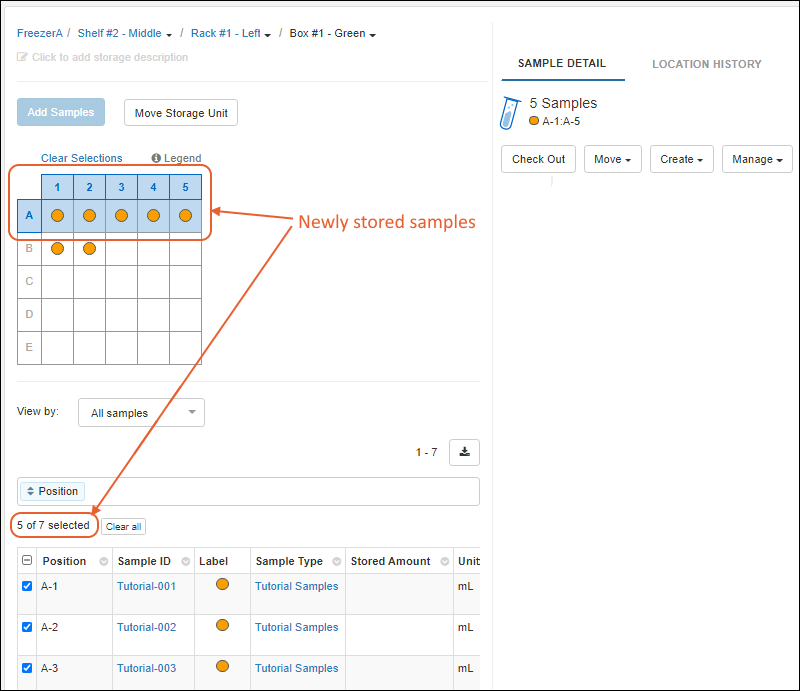
Start from a Picklist or Grid of Samples
Instead of starting from the Freezer, as described above, you can add Samples to freezer storage starting from the sample grid, either while viewing the Sample Type as a whole, or starting from a curated
picklist.
Select Samples to Store
Open the grid of Samples of interest. Either select the
Sample Type from the main menu, or choose
Picklists from the user menu and click the name of the picklist you want. On the grid, identify the Samples you want to store. Only Samples with a
Storage Status of "Not in storage" can be added to a freezer
Use checkboxes to select the Samples, then select
Storage > Add to storage above the grid.
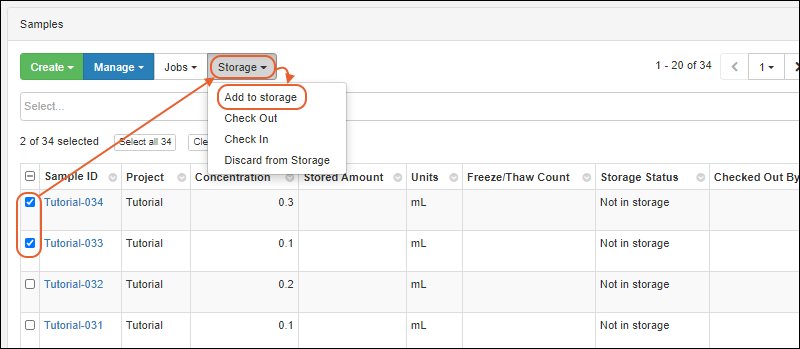
If you are viewing details for an individual sample, you can also click
Add to Storage from the
Storage Location panel.
Find Storage Location for Samples
In the
Assign Samples to Storage popup, you will see freezers with available storage space. The number of spaces available at each level will help you see easily where there is room for your new samples. Any locations without sufficient capacity to hold the samples you selected will show a red
icon.
Use the
icons to expand the hierarchy of the freezer of your choice, seeing available spaces at each level. When you find the desired terminal storage unit, click
Select.
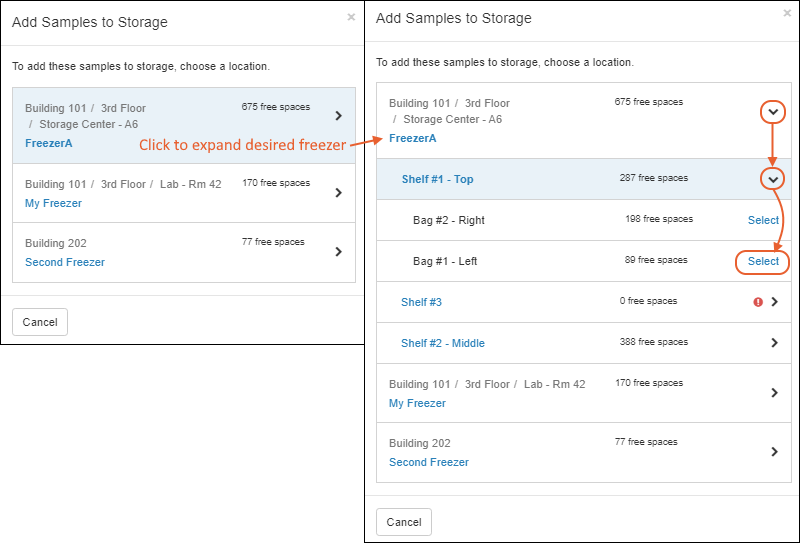
You will see the same interface for assigning locations to your selected samples as if you had
started from the freezer to store them .
- Populate the grid.
- For boxes, plates, and tube racks, the samples will default to the first available slots in the structured layout.
- Move the rows to other grid positions to change where in the unit you will store them.
- Click Add to [Storage Type] to complete the position assignments.
Related Topics